Taxation Law Assignment: Ordinary Income, CGT and Business Income
VerifiedAdded on 2023/04/21
|8
|1763
|321
Homework Assignment
AI Summary
This taxation law assignment analyzes a case study involving Megan Marvel, a senior executive who engages in various financial activities. The assignment addresses whether Megan's income from salary, a prize, restrictive covenants, grape farming, and land development constitutes assessable income under the Income Tax Assessment Act 1997 (ITAA 1997). The solution examines the application of relevant legal principles, including the definition of ordinary income, CGT event D1, and business income. It references key cases such as Scott v CT, Kelly v FC of T, Higgs v Olivier, FC of T v JR Walker, and FC of T v Whitfords Beach Pty Ltd to support its conclusions. The analysis determines the tax implications of each activity, concluding that Megan's salary, prize, and income from grape farming and land development are assessable, while the payment for restrictive covenants triggers a CGT event. The assignment demonstrates a comprehensive understanding of Australian taxation law principles and their practical application.
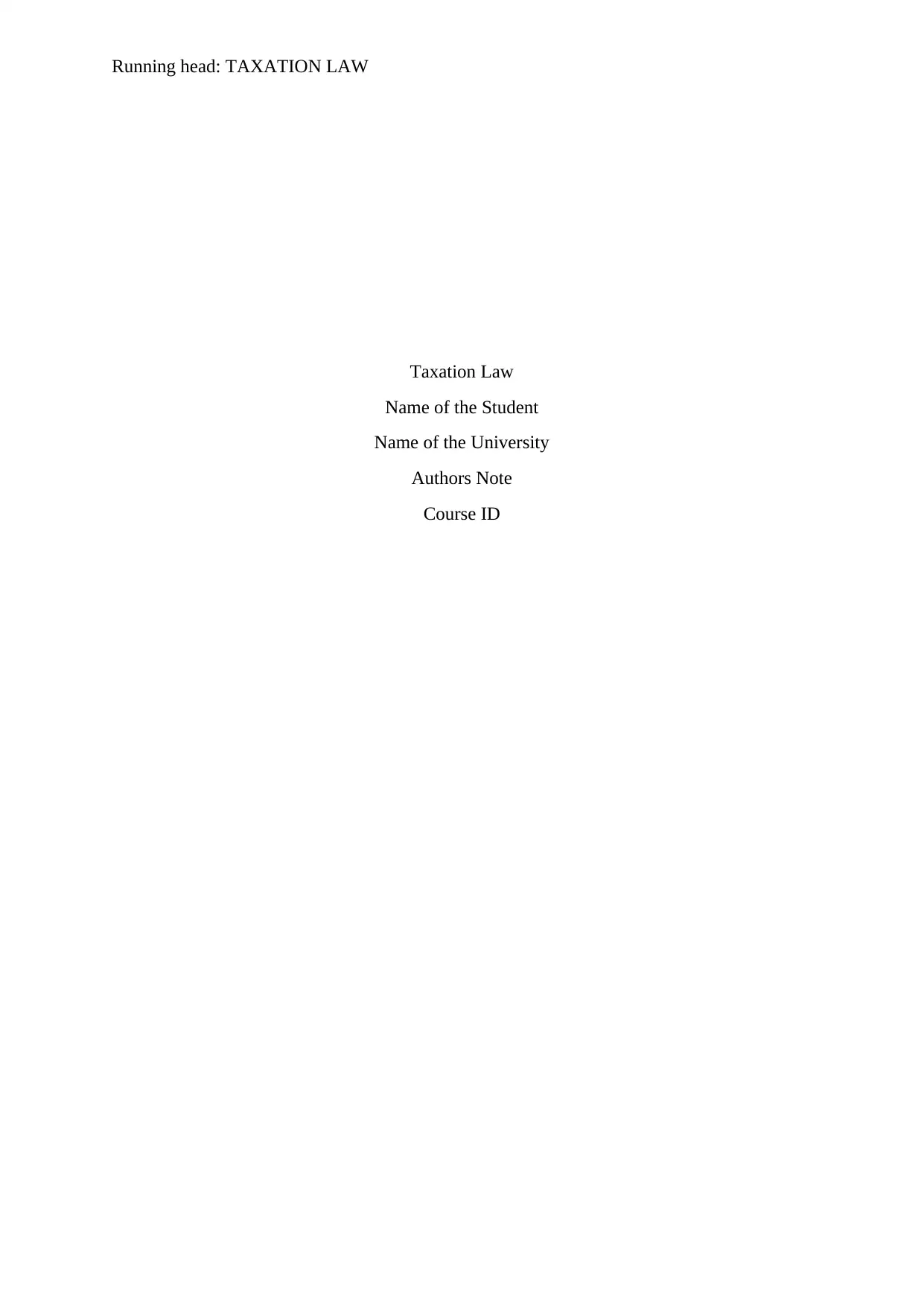
Running head: TAXATION LAW
Taxation Law
Name of the Student
Name of the University
Authors Note
Course ID
Taxation Law
Name of the Student
Name of the University
Authors Note
Course ID
Paraphrase This Document
Need a fresh take? Get an instant paraphrase of this document with our AI Paraphraser

1TAXATION LAW
Table of Contents
Part A:........................................................................................................................................2
Issues:.....................................................................................................................................2
Rule:.......................................................................................................................................2
Application:............................................................................................................................4
Conclusion:............................................................................................................................6
References:.................................................................................................................................7
Table of Contents
Part A:........................................................................................................................................2
Issues:.....................................................................................................................................2
Rule:.......................................................................................................................................2
Application:............................................................................................................................4
Conclusion:............................................................................................................................6
References:.................................................................................................................................7
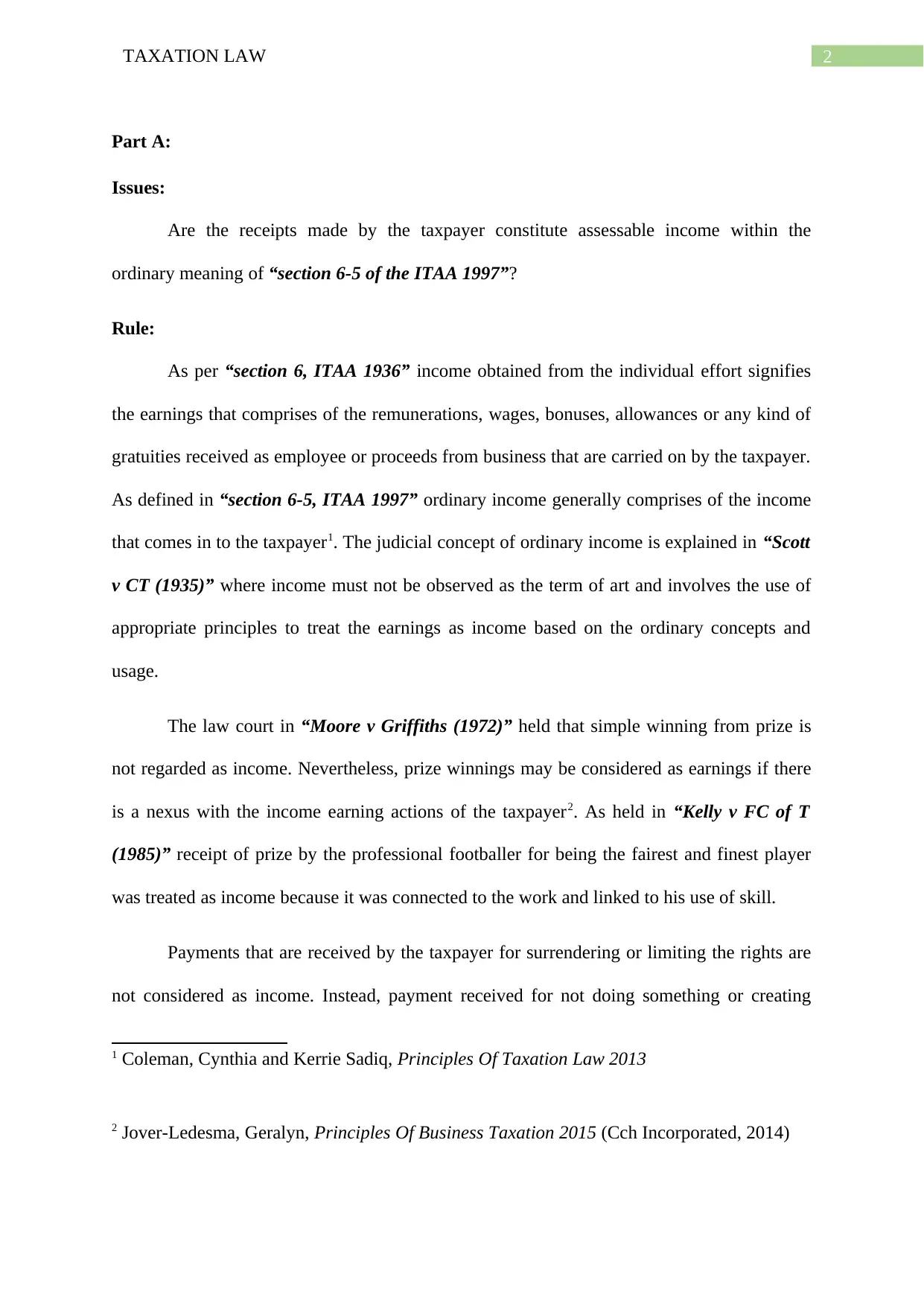
2TAXATION LAW
Part A:
Issues:
Are the receipts made by the taxpayer constitute assessable income within the
ordinary meaning of “section 6-5 of the ITAA 1997”?
Rule:
As per “section 6, ITAA 1936” income obtained from the individual effort signifies
the earnings that comprises of the remunerations, wages, bonuses, allowances or any kind of
gratuities received as employee or proceeds from business that are carried on by the taxpayer.
As defined in “section 6-5, ITAA 1997” ordinary income generally comprises of the income
that comes in to the taxpayer1. The judicial concept of ordinary income is explained in “Scott
v CT (1935)” where income must not be observed as the term of art and involves the use of
appropriate principles to treat the earnings as income based on the ordinary concepts and
usage.
The law court in “Moore v Griffiths (1972)” held that simple winning from prize is
not regarded as income. Nevertheless, prize winnings may be considered as earnings if there
is a nexus with the income earning actions of the taxpayer2. As held in “Kelly v FC of T
(1985)” receipt of prize by the professional footballer for being the fairest and finest player
was treated as income because it was connected to the work and linked to his use of skill.
Payments that are received by the taxpayer for surrendering or limiting the rights are
not considered as income. Instead, payment received for not doing something or creating
1 Coleman, Cynthia and Kerrie Sadiq, Principles Of Taxation Law 2013
2 Jover-Ledesma, Geralyn, Principles Of Business Taxation 2015 (Cch Incorporated, 2014)
Part A:
Issues:
Are the receipts made by the taxpayer constitute assessable income within the
ordinary meaning of “section 6-5 of the ITAA 1997”?
Rule:
As per “section 6, ITAA 1936” income obtained from the individual effort signifies
the earnings that comprises of the remunerations, wages, bonuses, allowances or any kind of
gratuities received as employee or proceeds from business that are carried on by the taxpayer.
As defined in “section 6-5, ITAA 1997” ordinary income generally comprises of the income
that comes in to the taxpayer1. The judicial concept of ordinary income is explained in “Scott
v CT (1935)” where income must not be observed as the term of art and involves the use of
appropriate principles to treat the earnings as income based on the ordinary concepts and
usage.
The law court in “Moore v Griffiths (1972)” held that simple winning from prize is
not regarded as income. Nevertheless, prize winnings may be considered as earnings if there
is a nexus with the income earning actions of the taxpayer2. As held in “Kelly v FC of T
(1985)” receipt of prize by the professional footballer for being the fairest and finest player
was treated as income because it was connected to the work and linked to his use of skill.
Payments that are received by the taxpayer for surrendering or limiting the rights are
not considered as income. Instead, payment received for not doing something or creating
1 Coleman, Cynthia and Kerrie Sadiq, Principles Of Taxation Law 2013
2 Jover-Ledesma, Geralyn, Principles Of Business Taxation 2015 (Cch Incorporated, 2014)
⊘ This is a preview!⊘
Do you want full access?
Subscribe today to unlock all pages.

Trusted by 1+ million students worldwide
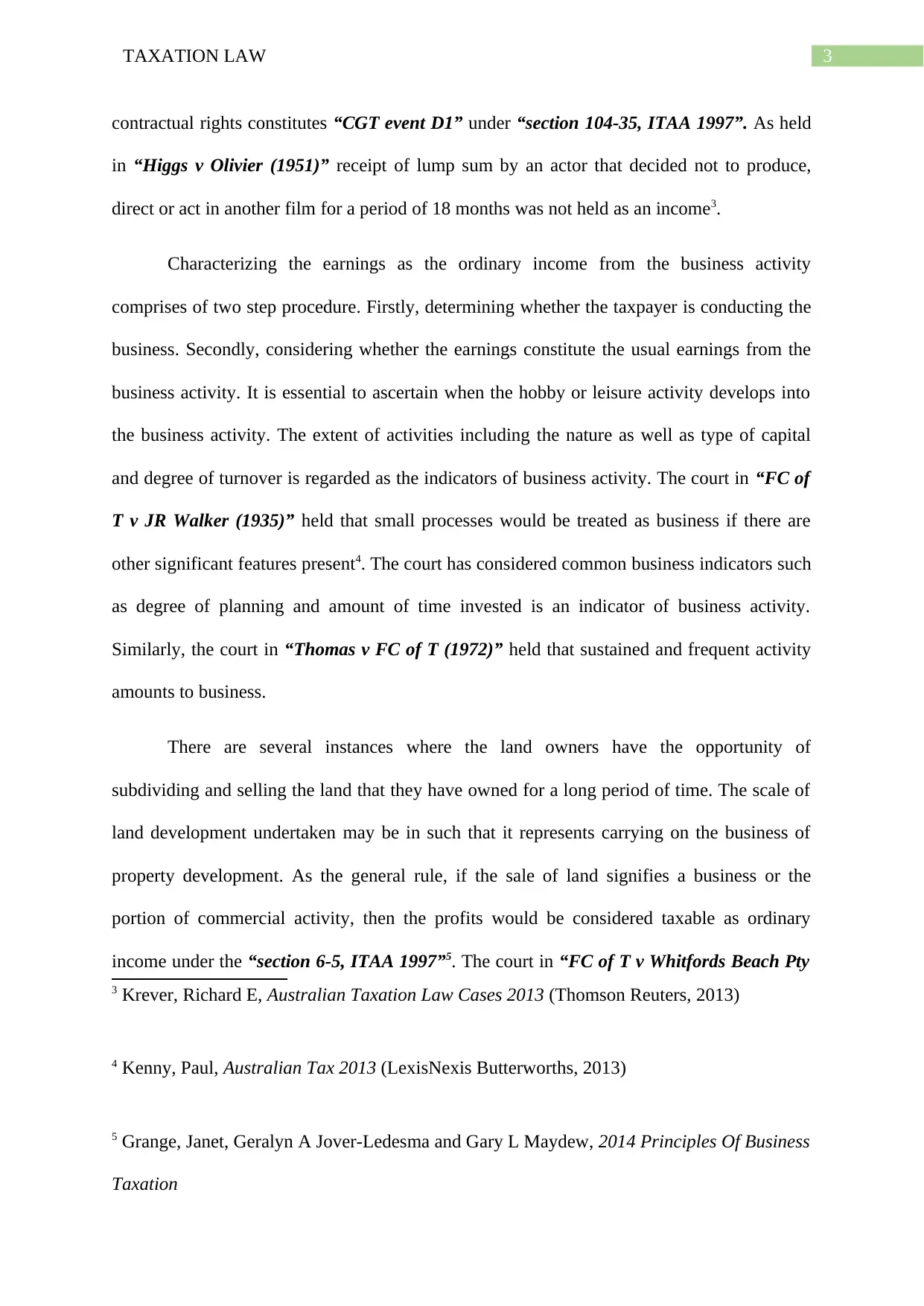
3TAXATION LAW
contractual rights constitutes “CGT event D1” under “section 104-35, ITAA 1997”. As held
in “Higgs v Olivier (1951)” receipt of lump sum by an actor that decided not to produce,
direct or act in another film for a period of 18 months was not held as an income3.
Characterizing the earnings as the ordinary income from the business activity
comprises of two step procedure. Firstly, determining whether the taxpayer is conducting the
business. Secondly, considering whether the earnings constitute the usual earnings from the
business activity. It is essential to ascertain when the hobby or leisure activity develops into
the business activity. The extent of activities including the nature as well as type of capital
and degree of turnover is regarded as the indicators of business activity. The court in “FC of
T v JR Walker (1935)” held that small processes would be treated as business if there are
other significant features present4. The court has considered common business indicators such
as degree of planning and amount of time invested is an indicator of business activity.
Similarly, the court in “Thomas v FC of T (1972)” held that sustained and frequent activity
amounts to business.
There are several instances where the land owners have the opportunity of
subdividing and selling the land that they have owned for a long period of time. The scale of
land development undertaken may be in such that it represents carrying on the business of
property development. As the general rule, if the sale of land signifies a business or the
portion of commercial activity, then the profits would be considered taxable as ordinary
income under the “section 6-5, ITAA 1997”5. The court in “FC of T v Whitfords Beach Pty
3 Krever, Richard E, Australian Taxation Law Cases 2013 (Thomson Reuters, 2013)
4 Kenny, Paul, Australian Tax 2013 (LexisNexis Butterworths, 2013)
5 Grange, Janet, Geralyn A Jover-Ledesma and Gary L Maydew, 2014 Principles Of Business
Taxation
contractual rights constitutes “CGT event D1” under “section 104-35, ITAA 1997”. As held
in “Higgs v Olivier (1951)” receipt of lump sum by an actor that decided not to produce,
direct or act in another film for a period of 18 months was not held as an income3.
Characterizing the earnings as the ordinary income from the business activity
comprises of two step procedure. Firstly, determining whether the taxpayer is conducting the
business. Secondly, considering whether the earnings constitute the usual earnings from the
business activity. It is essential to ascertain when the hobby or leisure activity develops into
the business activity. The extent of activities including the nature as well as type of capital
and degree of turnover is regarded as the indicators of business activity. The court in “FC of
T v JR Walker (1935)” held that small processes would be treated as business if there are
other significant features present4. The court has considered common business indicators such
as degree of planning and amount of time invested is an indicator of business activity.
Similarly, the court in “Thomas v FC of T (1972)” held that sustained and frequent activity
amounts to business.
There are several instances where the land owners have the opportunity of
subdividing and selling the land that they have owned for a long period of time. The scale of
land development undertaken may be in such that it represents carrying on the business of
property development. As the general rule, if the sale of land signifies a business or the
portion of commercial activity, then the profits would be considered taxable as ordinary
income under the “section 6-5, ITAA 1997”5. The court in “FC of T v Whitfords Beach Pty
3 Krever, Richard E, Australian Taxation Law Cases 2013 (Thomson Reuters, 2013)
4 Kenny, Paul, Australian Tax 2013 (LexisNexis Butterworths, 2013)
5 Grange, Janet, Geralyn A Jover-Ledesma and Gary L Maydew, 2014 Principles Of Business
Taxation
Paraphrase This Document
Need a fresh take? Get an instant paraphrase of this document with our AI Paraphraser

4TAXATION LAW
Ltd (1982)” held that the taxpayer was taxable for the profits made upon the disposal of land
under the “section 25 (1)” because it has gone outside the mere realisation of capital asset
and the taxpayer’s activities instituted performing on the business of land development.
Application:
Megan Marvel worked as the senior executive for the Paradigm Films and derived a
salary of $250,000 on yearly basis. Under “section 6, ITAA 1936” the earnings from salary
signifies earnings derived from the individual effort. Citing the case of “Scott v CT (1935)”
the salary received by Megan will be treated as ordinary income within the ordinary concept
of “section 6-5, ITAA 1997”.
In the later stages it is noticed Megan received a prize of gold statue that has the
worth of $20,000. The receipt of prize will be treated as assessable income because there is a
nexus with the income earning activities of Megan. Referring to the case of “Kelly v FC of T
(1985)” the receipt of award by Megan represents ordinary income within the judicial
meaning of “section 6-5 of the ITAA 1997” because it was related to the work and
interrelated to her use of skill6.
When Megan left her job she entered in a contract with Paradigm Film where she
agreed not to work in the film industry for two years and in return received a payment of
$500,000. Citing the case of “Higgs v Olivier (1951)” the payment received by Megan for
restricting rights cannot be regarded as income7. This is because the payment received by
6 Morgan, Annette, Colleen Mortimer and Dale Pinto, A Practical Introduction To Australian
Taxation Law (CCH Australia, 2013)
7 Robin, H. Australian Taxation Law 2019. Oxford University Press, 2019.
Ltd (1982)” held that the taxpayer was taxable for the profits made upon the disposal of land
under the “section 25 (1)” because it has gone outside the mere realisation of capital asset
and the taxpayer’s activities instituted performing on the business of land development.
Application:
Megan Marvel worked as the senior executive for the Paradigm Films and derived a
salary of $250,000 on yearly basis. Under “section 6, ITAA 1936” the earnings from salary
signifies earnings derived from the individual effort. Citing the case of “Scott v CT (1935)”
the salary received by Megan will be treated as ordinary income within the ordinary concept
of “section 6-5, ITAA 1997”.
In the later stages it is noticed Megan received a prize of gold statue that has the
worth of $20,000. The receipt of prize will be treated as assessable income because there is a
nexus with the income earning activities of Megan. Referring to the case of “Kelly v FC of T
(1985)” the receipt of award by Megan represents ordinary income within the judicial
meaning of “section 6-5 of the ITAA 1997” because it was related to the work and
interrelated to her use of skill6.
When Megan left her job she entered in a contract with Paradigm Film where she
agreed not to work in the film industry for two years and in return received a payment of
$500,000. Citing the case of “Higgs v Olivier (1951)” the payment received by Megan for
restricting rights cannot be regarded as income7. This is because the payment received by
6 Morgan, Annette, Colleen Mortimer and Dale Pinto, A Practical Introduction To Australian
Taxation Law (CCH Australia, 2013)
7 Robin, H. Australian Taxation Law 2019. Oxford University Press, 2019.

5TAXATION LAW
Megan is for agreeing not to do something. Instead, the sum of $500,000 will be treated as
“CGT event D1” under “section 104-35, ITAA 1997”.
Later Megan began growing grapes for commercial use. She also employed two
students on the part-time basis to assist her in looking after the vines. Megan later realised
that she is harvesting a significant amount of grapes which she sold to the local winemakers.
Megan also keeps the record of income and expenses8. The activities of Megan represent
conducting the business. The earnings constitute the usual earnings of Megan’s business
activity. The degree of activities together with the nature as well as type of capital and degree
of turnover made by Megan is regarded as the indicators of business activity.
To support this, reference to the case of “FC of T v JR Walker (1935)” can be made
as the common indicators such as keeping records of income and expenses and attending
lectures on growing grapes for commercial use reflects business practices that constant with
industry. Citing “Thomas v FC of T (1972)” the output produced by Megan was much
greater than what was commercially required while growing and selling the grown grapes to
the local winemaker represents commercial approach9. The sum of $100,000 will be included
for assessment under the ordinary concepts of “section 6-5, ITAA 1997”.
Megan was later approached by the property developer that advised her to subdivide
the farm building and build the same into 25 townhouses. Megan redeveloped the Lot B into
townhouse and sold the 25 townhouse for $37.5 million. The scale of land development
undertaken by Megan is such that it represents carrying on the business of property
development. Citing the case of “FC of T v Whitfords Beach Pty Ltd (1982)” Megan will be
8 Barkoczy, Stephen. "Foundations of taxation law 2016." OUP Catalogue (2016).
9 Woellner, Robin, et al. "Australian Taxation Law 2016." OUP Catalogue (2016).
Megan is for agreeing not to do something. Instead, the sum of $500,000 will be treated as
“CGT event D1” under “section 104-35, ITAA 1997”.
Later Megan began growing grapes for commercial use. She also employed two
students on the part-time basis to assist her in looking after the vines. Megan later realised
that she is harvesting a significant amount of grapes which she sold to the local winemakers.
Megan also keeps the record of income and expenses8. The activities of Megan represent
conducting the business. The earnings constitute the usual earnings of Megan’s business
activity. The degree of activities together with the nature as well as type of capital and degree
of turnover made by Megan is regarded as the indicators of business activity.
To support this, reference to the case of “FC of T v JR Walker (1935)” can be made
as the common indicators such as keeping records of income and expenses and attending
lectures on growing grapes for commercial use reflects business practices that constant with
industry. Citing “Thomas v FC of T (1972)” the output produced by Megan was much
greater than what was commercially required while growing and selling the grown grapes to
the local winemaker represents commercial approach9. The sum of $100,000 will be included
for assessment under the ordinary concepts of “section 6-5, ITAA 1997”.
Megan was later approached by the property developer that advised her to subdivide
the farm building and build the same into 25 townhouses. Megan redeveloped the Lot B into
townhouse and sold the 25 townhouse for $37.5 million. The scale of land development
undertaken by Megan is such that it represents carrying on the business of property
development. Citing the case of “FC of T v Whitfords Beach Pty Ltd (1982)” Megan will be
8 Barkoczy, Stephen. "Foundations of taxation law 2016." OUP Catalogue (2016).
9 Woellner, Robin, et al. "Australian Taxation Law 2016." OUP Catalogue (2016).
⊘ This is a preview!⊘
Do you want full access?
Subscribe today to unlock all pages.

Trusted by 1+ million students worldwide
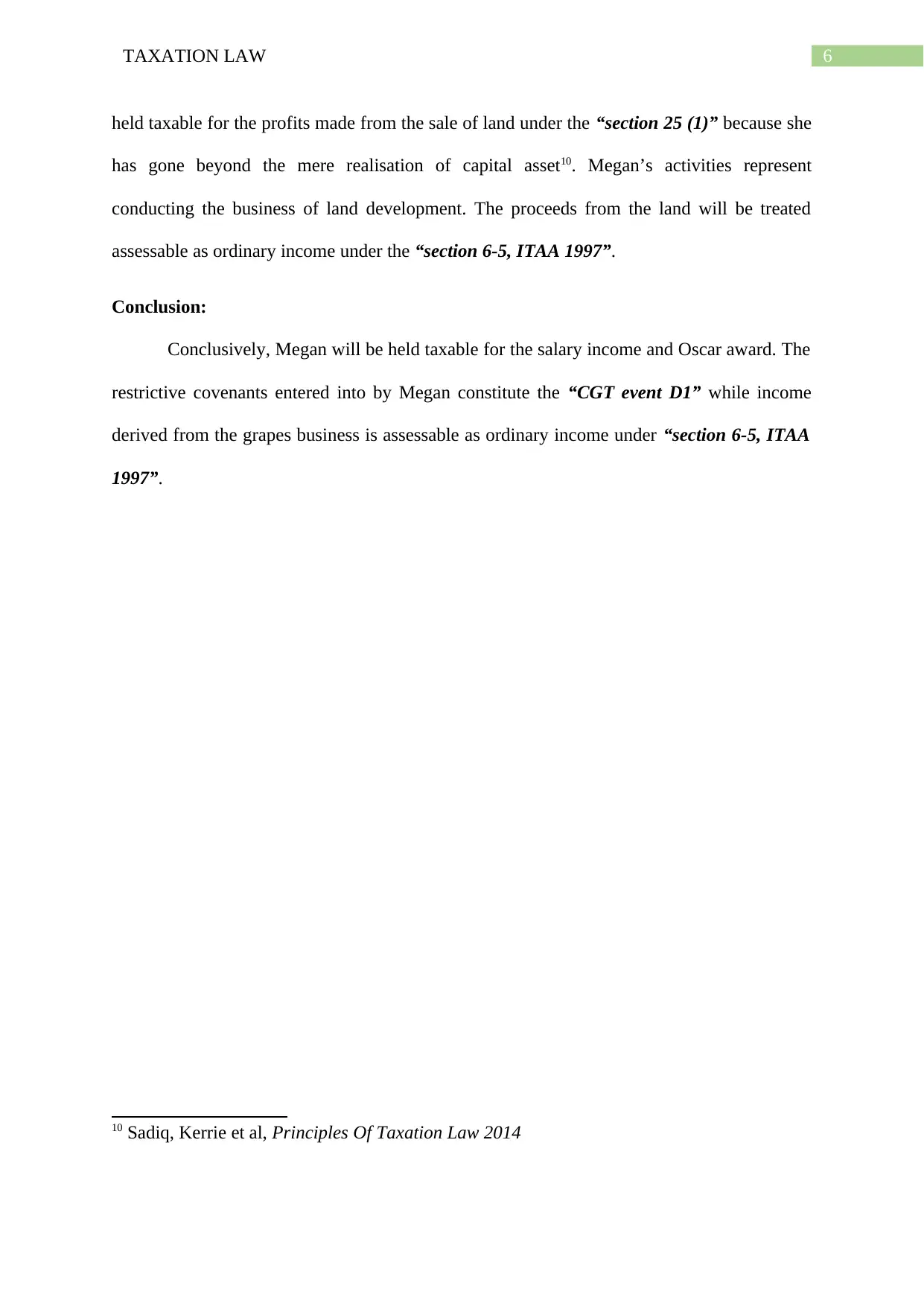
6TAXATION LAW
held taxable for the profits made from the sale of land under the “section 25 (1)” because she
has gone beyond the mere realisation of capital asset10. Megan’s activities represent
conducting the business of land development. The proceeds from the land will be treated
assessable as ordinary income under the “section 6-5, ITAA 1997”.
Conclusion:
Conclusively, Megan will be held taxable for the salary income and Oscar award. The
restrictive covenants entered into by Megan constitute the “CGT event D1” while income
derived from the grapes business is assessable as ordinary income under “section 6-5, ITAA
1997”.
10 Sadiq, Kerrie et al, Principles Of Taxation Law 2014
held taxable for the profits made from the sale of land under the “section 25 (1)” because she
has gone beyond the mere realisation of capital asset10. Megan’s activities represent
conducting the business of land development. The proceeds from the land will be treated
assessable as ordinary income under the “section 6-5, ITAA 1997”.
Conclusion:
Conclusively, Megan will be held taxable for the salary income and Oscar award. The
restrictive covenants entered into by Megan constitute the “CGT event D1” while income
derived from the grapes business is assessable as ordinary income under “section 6-5, ITAA
1997”.
10 Sadiq, Kerrie et al, Principles Of Taxation Law 2014
Paraphrase This Document
Need a fresh take? Get an instant paraphrase of this document with our AI Paraphraser
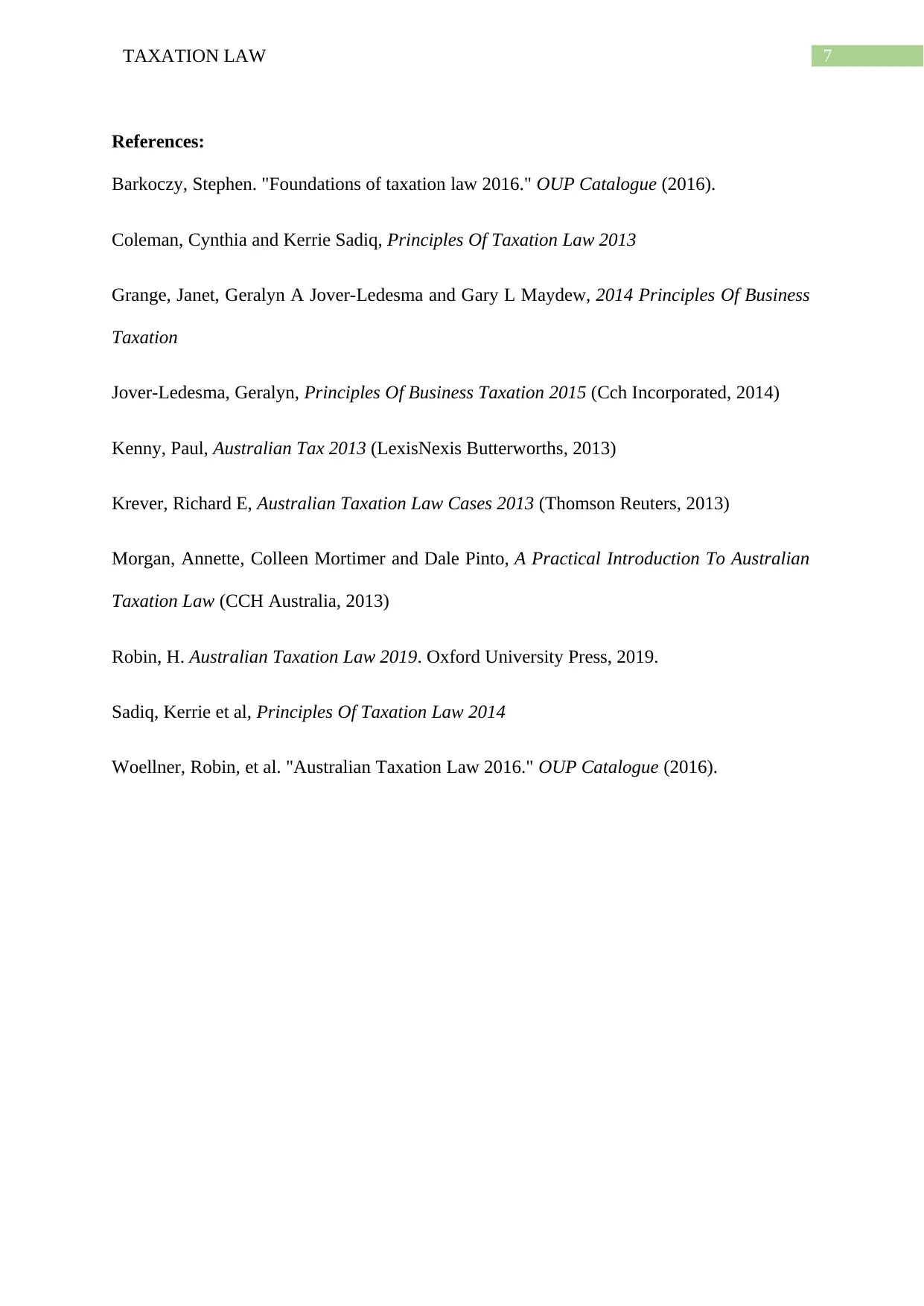
7TAXATION LAW
References:
Barkoczy, Stephen. "Foundations of taxation law 2016." OUP Catalogue (2016).
Coleman, Cynthia and Kerrie Sadiq, Principles Of Taxation Law 2013
Grange, Janet, Geralyn A Jover-Ledesma and Gary L Maydew, 2014 Principles Of Business
Taxation
Jover-Ledesma, Geralyn, Principles Of Business Taxation 2015 (Cch Incorporated, 2014)
Kenny, Paul, Australian Tax 2013 (LexisNexis Butterworths, 2013)
Krever, Richard E, Australian Taxation Law Cases 2013 (Thomson Reuters, 2013)
Morgan, Annette, Colleen Mortimer and Dale Pinto, A Practical Introduction To Australian
Taxation Law (CCH Australia, 2013)
Robin, H. Australian Taxation Law 2019. Oxford University Press, 2019.
Sadiq, Kerrie et al, Principles Of Taxation Law 2014
Woellner, Robin, et al. "Australian Taxation Law 2016." OUP Catalogue (2016).
References:
Barkoczy, Stephen. "Foundations of taxation law 2016." OUP Catalogue (2016).
Coleman, Cynthia and Kerrie Sadiq, Principles Of Taxation Law 2013
Grange, Janet, Geralyn A Jover-Ledesma and Gary L Maydew, 2014 Principles Of Business
Taxation
Jover-Ledesma, Geralyn, Principles Of Business Taxation 2015 (Cch Incorporated, 2014)
Kenny, Paul, Australian Tax 2013 (LexisNexis Butterworths, 2013)
Krever, Richard E, Australian Taxation Law Cases 2013 (Thomson Reuters, 2013)
Morgan, Annette, Colleen Mortimer and Dale Pinto, A Practical Introduction To Australian
Taxation Law (CCH Australia, 2013)
Robin, H. Australian Taxation Law 2019. Oxford University Press, 2019.
Sadiq, Kerrie et al, Principles Of Taxation Law 2014
Woellner, Robin, et al. "Australian Taxation Law 2016." OUP Catalogue (2016).
1 out of 8
Related Documents
Your All-in-One AI-Powered Toolkit for Academic Success.
+13062052269
info@desklib.com
Available 24*7 on WhatsApp / Email
![[object Object]](/_next/static/media/star-bottom.7253800d.svg)
Unlock your academic potential
Copyright © 2020–2025 A2Z Services. All Rights Reserved. Developed and managed by ZUCOL.





